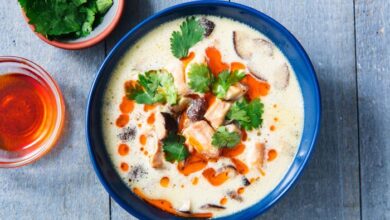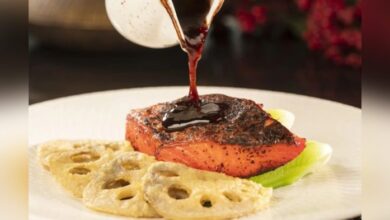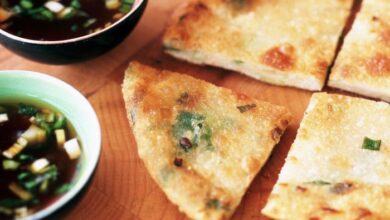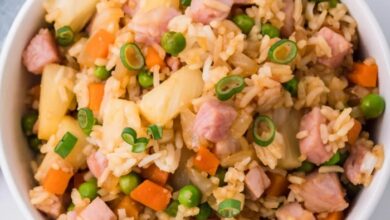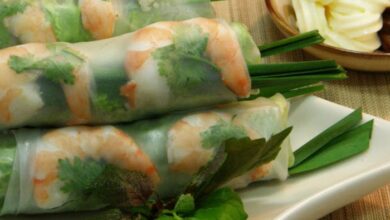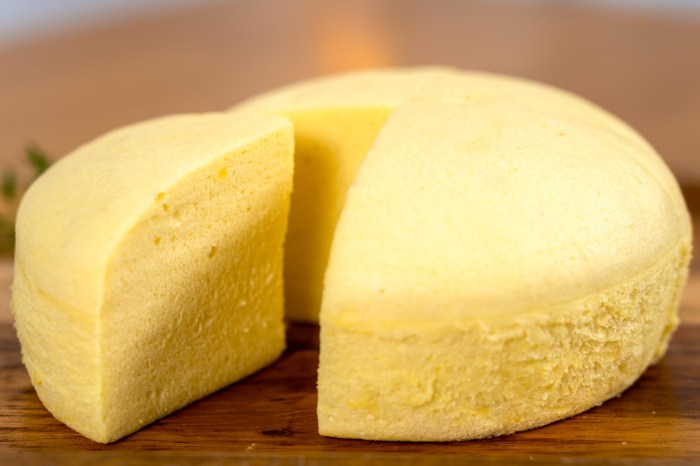
Traditional Chinese Steamed Cake Fa Gao: A Culinary Journey
Traditional Chinese steamed cake Fa Gao, a fluffy and flavorful delicacy, holds a special place in Chinese culinary history. This steamed cake, often enjoyed during festive occasions and family gatherings, represents a rich cultural heritage that spans centuries. From its humble beginnings to its modern interpretations, Fa Gao continues to enchant palates with its delicate texture and diverse flavor profiles.
Fa Gao, also known as “prosperity cake,” symbolizes good fortune and abundance in Chinese culture. Its name, which translates to “prosperous cake,” reflects the hope for a bountiful year and prosperity. This auspicious association has cemented Fa Gao’s place in Chinese traditions, making it a staple at celebrations like weddings, birthdays, and the Lunar New Year.
Fa Gao
Fa Gao, also known as “Prosperity Cake” or “发糕” in Chinese, is a traditional steamed cake popular in various regions of China. It holds significant cultural and symbolic meaning, representing prosperity, good fortune, and a bountiful harvest.
History and Cultural Significance
Fa Gao’s history is deeply intertwined with Chinese culture and traditions. Its origins can be traced back to ancient China, where rice flour was a staple ingredient in many cuisines. Over time, the cake evolved into a symbolic dish, often prepared during special occasions and festivals.
The name “Fa Gao” itself is derived from the Chinese word “发” (fa), which means “to prosper” or “to rise,” signifying good fortune and abundance. In Chinese culture, the cake’s rising during the steaming process is seen as a symbol of progress and growth, making it an auspicious food for celebrations.
Origins and Evolution of Fa Gao Recipes
Fa Gao recipes have evolved over centuries, adapting to regional preferences and ingredient availability. The basic recipe typically consists of rice flour, sugar, yeast, and water. However, variations in ingredients and techniques have emerged, resulting in diverse flavors and textures.
- Northern Fa Gaooften incorporates ingredients like glutinous rice flour, creating a chewier texture. It may also feature fillings like red bean paste or dates, adding sweetness and richness.
- Southern Fa Gaotends to be lighter and fluffier, utilizing more white rice flour and sometimes incorporating ingredients like coconut milk or pandan leaves for unique aromas.
Traditional Stories and Folklore
Fa Gao is associated with various traditional stories and folklore that have been passed down through generations. One popular story tells of a poor farmer who, despite facing hardships, was able to harvest a bountiful crop thanks to a magical cake that he found.
This story highlights the cake’s association with prosperity and good fortune.Another tale describes a young woman who, on her wedding day, baked a Fa Gao that rose high and beautifully, symbolizing a happy and prosperous marriage. These stories underscore the cake’s significance as a symbol of hope, good luck, and a bright future.
Ingredients and Preparation: Traditional Chinese Steamed Cake Fa Gao
Fa Gao, also known as “prosperity cake,” is a delightful steamed cake that symbolizes good fortune and prosperity in Chinese culture. The preparation of this cake is a testament to the simplicity and elegance of traditional Chinese cuisine. Its fluffy texture and subtle sweetness are a result of the careful selection and combination of ingredients.
Ingredients and Their Roles
The essential ingredients for a basic Fa Gao recipe are:
- Glutinous Rice Flour:This is the primary ingredient, providing the cake’s characteristic chewy texture. Glutinous rice flour is made from finely ground glutinous rice, which contains a high percentage of amylopectin, a type of starch that absorbs water and gelatinizes upon heating.
This gelatinization process is what gives Fa Gao its unique texture.
- Sugar:Sugar adds sweetness and helps to balance the slightly savory flavor of the glutinous rice flour. The amount of sugar can be adjusted to taste preference.
- Yeast:Yeast is the leavening agent responsible for the cake’s airy texture. It ferments the sugar, producing carbon dioxide gas that creates small bubbles in the batter, resulting in a light and fluffy cake. Active dry yeast is commonly used, and it needs to be activated in warm water before adding it to the batter.
Fa Gao, the traditional Chinese steamed cake, is a delightful treat, especially when paired with a savory side dish. For a truly satisfying meal, I recommend trying the slow cooker baby back ribs recipe on Cerita Kuliner. The tender, fall-off-the-bone ribs are the perfect complement to the sweet and fluffy fa gao, creating a balanced and delicious culinary experience.
- Water:Water is essential for hydration and for activating the yeast. The amount of water may need to be adjusted depending on the humidity and the type of glutinous rice flour used.
- Optional Ingredients:Depending on personal preference, other ingredients can be added to enhance the flavor and appearance of Fa Gao. These can include:
- Milk:Adds richness and creaminess to the cake.
- Eggs:Contribute to a richer flavor and a slightly denser texture.
- Dried Fruits:Raisins, cranberries, or chopped dates can add sweetness and texture to the cake.
- Nuts:Chopped walnuts, almonds, or peanuts can provide a crunchy texture and a nutty flavor.
- Citrus Zest:Lemon or orange zest adds a refreshing citrus aroma and flavor.
Ingredient Variations and Their Effects
The following table Artikels the effects of different ingredient variations on the final product:
| Ingredient Variation | Effect on Fa Gao |
|---|---|
| Increased Glutinous Rice Flour | Chewier and denser texture |
| Decreased Glutinous Rice Flour | Softer and lighter texture |
| Increased Sugar | Sweeter flavor |
| Decreased Sugar | Less sweet flavor |
| Increased Yeast | More airy and fluffy texture |
| Decreased Yeast | Denser and less airy texture |
| Increased Water | Softer and more moist texture |
| Decreased Water | Drier and more crumbly texture |
| Adding Milk | Richer and creamier flavor |
| Adding Eggs | Richer flavor and slightly denser texture |
| Adding Dried Fruits | Sweetness and texture |
| Adding Nuts | Crunchy texture and nutty flavor |
| Adding Citrus Zest | Refreshing citrus aroma and flavor |
Steaming Techniques and Variations
The art of steaming Fa Gao lies in achieving a delicate balance of texture and flavor. Traditional methods focus on gentle, even heat distribution to ensure the cake rises beautifully and cooks through without drying out. This section delves into the nuances of steaming techniques and how they impact the final product.
Traditional Steaming Methods
Traditional steaming methods for Fa Gao often involve using a bamboo steamer, a time-honored technique that allows for consistent heat circulation and prevents the cake from sticking. The steamer is typically placed over a pot of boiling water, creating a moist environment that encourages the cake to rise.
Fa Gao, the traditional Chinese steamed cake, is a staple in many households. Its fluffy texture and subtle sweetness are perfect for a light breakfast or afternoon snack. While Fa Gao is all about delicate flavors and gentle steaming, I recently discovered a dish that embraces bold flavors and a fiery oven: baked feta pasta with vegetables.
This simple yet satisfying dish is a testament to the power of contrasting flavors and textures. Just like Fa Gao brings comfort and familiarity, this baked pasta offers a burst of excitement and a reminder that culinary adventures can be found in unexpected places.
The heat from the water vapor gently cooks the cake, resulting in a soft, airy texture.
Comparison of Steaming Techniques
The choice of steaming method can significantly influence the outcome of your Fa Gao. Here’s a comparison of common techniques:
- Bamboo Steamer:Traditional and versatile, bamboo steamers provide excellent heat distribution and prevent sticking. They are readily available and relatively inexpensive. However, they may require a bit more attention to ensure even cooking.
- Metal Steamer:Metal steamers offer faster heating and more consistent results, especially for larger batches. They are also more durable and easier to clean than bamboo steamers. However, metal steamers can sometimes lead to uneven cooking if not properly monitored.
- Microwave Steaming:Microwave steaming is a convenient option for smaller portions. It offers faster cooking times but may result in a slightly denser texture compared to traditional steaming methods. It’s essential to use a microwave-safe container with a tight-fitting lid to prevent spills.
Fa Gao, a traditional Chinese steamed cake, is a staple in many celebrations. Its fluffy texture and subtle sweetness make it a perfect accompaniment to savory dishes, like the melt-in-your-mouth slow cooker pork rib tips I recently made. The richness of the ribs perfectly complements the light and airy fa gao, creating a balanced and delightful meal.
I find that the combination of these two dishes is a fantastic way to experience the diversity of Chinese cuisine.
Step-by-Step Guide for Steaming Fa Gao
Steaming Fa Gao is a relatively straightforward process, but a few key steps ensure even cooking and a beautiful outcome:
- Prepare the Steamer:Line the steamer basket with parchment paper or a reusable silicone liner to prevent sticking. Add a few cups of water to the pot below the steamer, ensuring it doesn’t touch the bottom of the steamer basket.
- Grease and Flour the Molds:Lightly grease and flour the molds you’ll be using for your Fa Gao. This will help prevent the cake from sticking and ensure a clean release.
- Fill the Molds:Pour the Fa Gao batter into the prepared molds, filling them about two-thirds full. This allows room for the cake to rise during steaming.
- Steam the Cake:Bring the water in the pot to a rolling boil. Place the steamer basket with the filled molds on top of the pot, ensuring the water doesn’t touch the bottom of the basket. Cover the steamer tightly and steam for 20-30 minutes, or until a toothpick inserted into the center comes out clean.
- Rest and Cool:After steaming, carefully remove the steamer basket from the pot. Let the Fa Gao rest in the molds for a few minutes before inverting them onto a wire rack to cool completely.
Tips for Even Cooking:
- Avoid overcrowding the steamer basket, allowing for adequate airflow.
- Monitor the water level in the pot and add more as needed to prevent it from boiling dry.
- Use a toothpick or a cake tester to check for doneness, ensuring the center is cooked through.
Flavors and Fillings
Fa Gao, the delightful steamed cake, offers a canvas for culinary creativity, allowing for a wide range of flavors and fillings to satisfy diverse palates. The versatility of Fa Gao lies in its ability to accommodate both sweet and savory options, resulting in a delightful array of taste experiences.
Flavor Profiles
The basic Fa Gao recipe provides a subtle sweetness that serves as a foundation for various flavor profiles. The addition of ingredients like brown sugar, honey, or even a touch of molasses can enhance the natural sweetness of the cake, creating a warm and comforting flavor.
Popular Fillings
The fillings used in Fa Gao play a crucial role in shaping its flavor and texture.
Sweet Fillings
Sweet fillings are particularly popular in Fa Gao, offering a delightful contrast to the cake’s subtle sweetness.
- Red Bean Paste:A classic and beloved filling, red bean paste provides a rich, earthy sweetness that complements the cake perfectly.
- Lotus Seed Paste:Known for its delicate sweetness and creamy texture, lotus seed paste is another popular choice for Fa Gao fillings.
- Mango:The tropical sweetness of mango adds a vibrant and refreshing touch to Fa Gao, creating a delightful combination of textures and flavors.
- Dates:Dates, with their natural sweetness and chewy texture, provide a unique and satisfying addition to Fa Gao.
Savory Fillings
While sweet fillings are more common, Fa Gao can also be enjoyed with savory fillings, offering a unique and satisfying twist.
- Pork:Ground pork, seasoned with soy sauce, ginger, and garlic, adds a savory and umami flavor to Fa Gao, creating a savory and satisfying treat.
- Mushrooms:Earthy and flavorful mushrooms, like shiitake or oyster mushrooms, provide a savory and textural element to Fa Gao.
- Vegetables:Chopped vegetables, such as carrots, cabbage, or scallions, add a refreshing and vibrant touch to Fa Gao, balancing the richness of the cake.
Regional Variations
Fa Gao’s popularity has led to regional variations in flavors and fillings, showcasing the diverse culinary traditions across China.
| Region | Flavor Profile | Fillings |
|---|---|---|
| Guangdong | Sweet and slightly tangy | Red bean paste, lotus seed paste, mung bean paste, sesame paste |
| Fujian | Rich and savory | Pork, shrimp, mushrooms, vegetables |
| Sichuan | Spicy and flavorful | Spicy pork, chili peppers, Sichuan peppercorns |
| Shanghai | Sweet and delicate | Black sesame paste, sweet potato, pumpkin |
Serving and Presentation
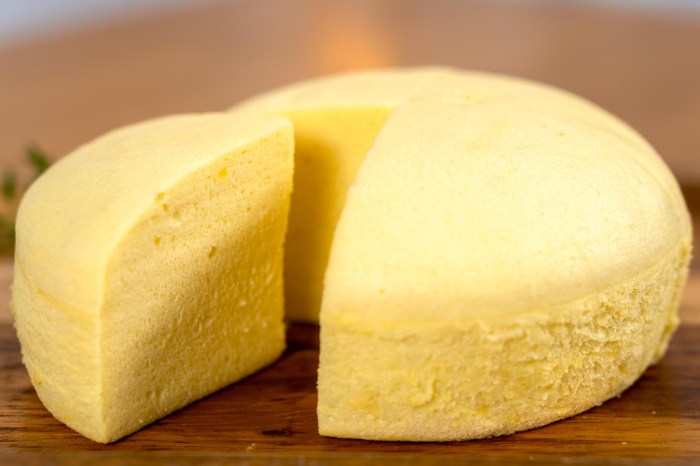
Fa Gao, with its soft, fluffy texture and delightful flavors, is not just a delicious treat but also a beautiful one, often presented with care and attention to detail. Serving and presentation are integral to the enjoyment of this traditional Chinese steamed cake, reflecting cultural nuances and enhancing the overall dining experience.
Traditional Serving Styles
Traditional serving styles for Fa Gao are influenced by regional customs and the occasion. In many parts of China, Fa Gao is served warm, often alongside a steaming cup of tea. The cake’s fluffy texture and mild sweetness pair well with the warm, comforting beverage.
- Accompanying Dishes:Fa Gao can be served as a standalone treat or as part of a larger meal. Common accompaniments include savory dishes like congee (rice porridge), dim sum, or stir-fried vegetables. The contrast in flavors and textures creates a well-rounded dining experience.
- Regional Variations:In some regions, Fa Gao is served with a sweet dipping sauce, such as honey or a simple sugar syrup. This adds an extra layer of sweetness and enhances the cake’s flavor profile.
Aesthetic Appeal and Cultural Context, Traditional chinese steamed cake fa gao
The visual appeal of Fa Gao is an essential aspect of its presentation. The cake’s golden-brown hue, achieved through steaming, evokes a sense of warmth and comfort. The soft, fluffy texture and delicate, often floral, flavors contribute to its aesthetic appeal.
- Symbolism:In Chinese culture, Fa Gao is often associated with prosperity and good fortune, making it a popular choice for special occasions such as weddings, birthdays, and festivals. The cake’s round shape symbolizes wholeness and unity, further reinforcing its auspicious connotations.
- Presentation:Fa Gao is often presented in a visually appealing manner, with delicate decorations and artistic arrangements. The cake’s simplicity allows for creative embellishments, reflecting the host’s hospitality and artistic sensibilities.
Creative Presentation Ideas
For special occasions, Fa Gao can be presented in creative and unique ways, adding a touch of elegance and sophistication to the dining experience.
- Floral Decorations:Edible flowers, such as rose petals or lavender blossoms, can be used to decorate the cake, adding a touch of natural beauty and delicate fragrance.
- Themed Presentation:For specific events, Fa Gao can be presented in themed arrangements. For example, for a Chinese New Year celebration, the cake could be decorated with red and gold accents, symbolizing prosperity and good luck.
- Layered Presentation:Fa Gao can be layered with different flavors and fillings, creating a visually stunning and delicious dessert. For example, a layer of sweet bean paste could be sandwiched between two layers of Fa Gao, creating a delightful contrast in textures and flavors.
Fa Gao in Modern Cuisine
Fa Gao, a traditional Chinese steamed cake, has transcended its roots and found a place in modern cuisine, inspiring innovative interpretations and captivating palates with its versatility. Contemporary chefs are embracing Fa Gao, showcasing its unique texture and flavor profile in contemporary culinary creations.
Reinterpretations and Adaptations
The traditional Fa Gao, known for its fluffy texture and subtle sweetness, has become a canvas for culinary experimentation. Modern chefs are reinterpreting this classic by incorporating novel ingredients, exploring different flavors, and pushing the boundaries of presentation. This evolution is driven by the desire to appeal to contemporary tastes while respecting the heritage of Fa Gao.
Innovative Recipes and Techniques
- Modernized Flavors: Chefs are introducing contemporary flavors to Fa Gao, infusing them with ingredients like matcha, black sesame, and even fruit purees, creating a vibrant and refreshing twist on the traditional recipe.
- Creative Fillings: Fa Gao is being elevated with innovative fillings, showcasing unexpected combinations like savory cheese and herbs, or sweet and tangy fruit compotes. This approach introduces a playful element to the traditional cake, appealing to adventurous eaters.
- Textural Explorations: Chefs are experimenting with different textures within the Fa Gao, incorporating ingredients like mochi, glutinous rice flour, and even incorporating a layer of crispy rice for added textural contrast.
- Modern Presentation: The presentation of Fa Gao has also undergone a transformation. Chefs are using modern plating techniques, incorporating colorful garnishes and artistic arrangements to enhance the visual appeal of the cake.

